| Back to Back Issues Page |
 |
|
Bangkok Travelbug November 12 The Bottle Art Museum Pattaya October 29, 2012 |
| Hello
Background to the Bottle Art Museum The Bottle Art Museum Pattaya was the brainchild of Pieter bij de Leij an artist from the Netherlands who started the museum in 1995. He had one student Prapaisri Taipanich who has carried on his legacy. She owns the museum now which has more than 300 exhibits. Other bottle art museums feature ships in bottles like museums in Enkhuizen Netherlands, Hamburg Germany, Liverpool England and San Francisco USA. Such exhibits are either part of maritime museums or in dedicated bottle art museums. However this museum specialises in building houses, places of worship and other famous structures in bottles. Many of these buildings have interesting stories too. 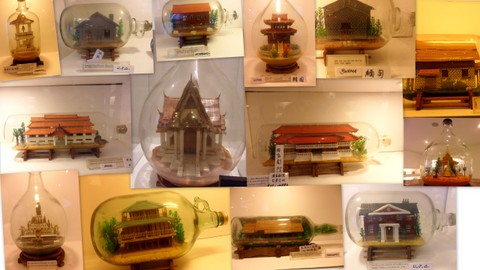
Table of contents Organisation of the Bottle Art Museum The Bottle Art Museum is organised into a number of rooms.
Table of contents Creating bottle art The video presentation in the reception room gives us an idea of the painstaking process in making bottle art.
Classes on bottle art are also conducted and those interested can call + 66 3842 2957. Let’s take a tour of this special museum to view the exquisite pieces of bottle art. Table of contents Bottle Art Museum – Room 1 Room 1 displays several models of old houses from various parts of the world. These models took one to three months to complete. 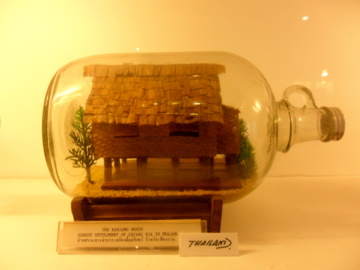
Kariang (Karen) house in Mae Jan, Chiang Rai The Kariang (Karen) are one of the six major hill tribes living in northern Thailand in the region of the Golden Triangle. They originate from Mongolia and later migrated to Myanmar and Thailand. 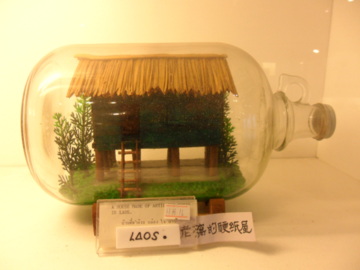
House made form artillery ammunition boxes, Laos 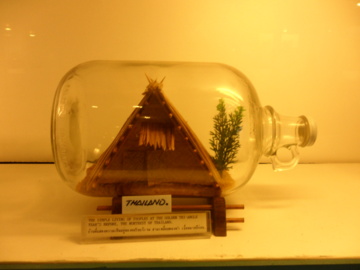
Simple thatched roof house of old in the Golden Triangle, northern Thailand 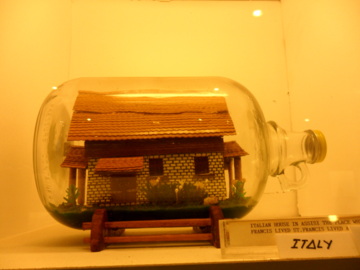
Home of St Francis of Assisi, Assisi Italy Francesco Bernadone (1181 – 1226) was born in the town of Assisi, Umbria in Italy. Born to a rich family, Francesco led a wild life as a young man. As he grew older, a change came over him. He forsook his family and wealth and lived in poverty as a wandering preacher caring for the poor. He founded the Franciscan Order. After his death, he was canonised as St Francis of Assisi. As he was kind to animals he was also made the patron saint for animals. Here are some old 18th and 19th century houses from the Netherlands. 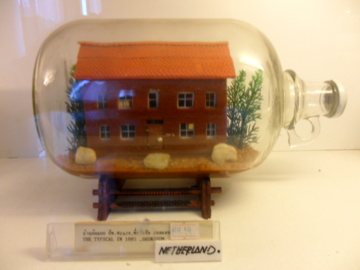
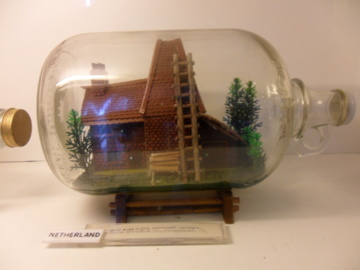
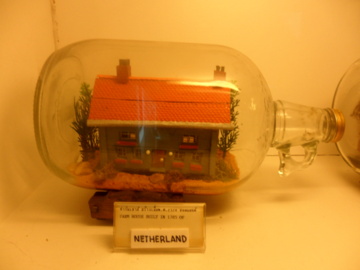
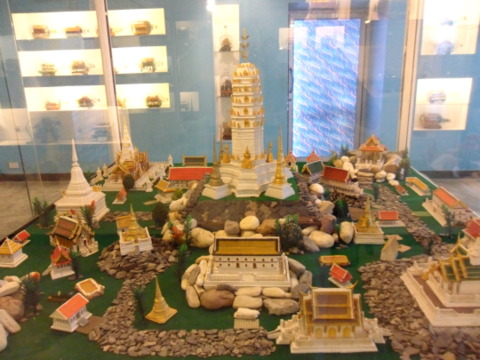
Temple complex – centrepiece display in Room 1 Table of contents Bottle Art Museum - Room 2 Room 2 features models of religious buildings from various parts of the world in bottles. These pieces took approximately four to five months to complete. 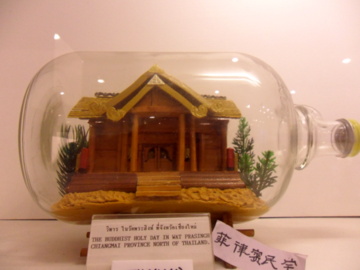
Wat Phra Singh Chiang Mai, Thailand Wat Phra Singh (Temple of the Lion Buddha) was built in 1345 by King Pha Yu (reign 1337 – 1355) of the Mangrai dynasty that ruled the Lanna kingdom in northern Thailand. The temple was built to keep the bones of the king’s father King Kham Fu. The temple was originally called Wat Li Chiang Phra. The name change was because the Phra Singh Buddha image (Lion Buddha) was housed there in 1367. There is another temple by the same name in Chiang Rai. 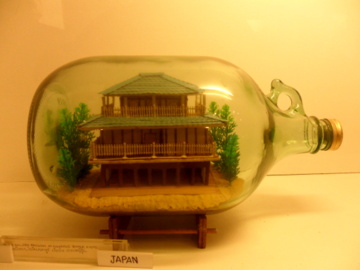
Kinakuji Temple, Kyoto, Japan Kinakuji Temple, popularly known as the Golden Pavilion, is an UNESCO World Heritage site. It’s known to be in existence since the early 13th century. The building was originally home of a former Shogun (hereditary military rulers of Japan from the 12th – 19th century). Upon his death the building was converted to a Zen temple in accordance with his will. 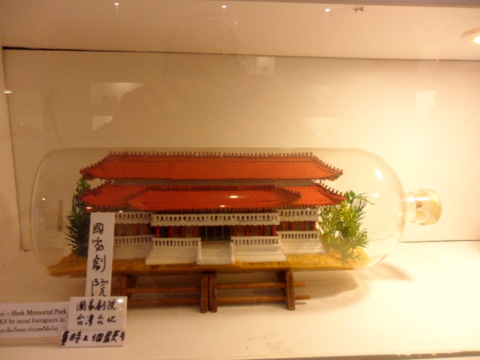
National Theatre, Chiang Kai Shek Memorial Park, Taipeh, Taiwan Chiang Kai Shek Memorial Hall opened on 5 April 1976 in memory of the late President Chiang Kai Shek. It’s in the Chiang Kai Shek Memorial Park where the National Theatre and National Concert Hall are located. Chiang Kai Shek assumed the leadership of the Chinese National Party (Kuomintang or KMT) after the death of the founder Dr Sun Yat Sen. Since 1931 the KMT was in constant struggle with the Communist Party of China, a conflict that was only interrupted by the Japanese invasion in 1937 and occupation of the coastal region of China. In 1945, after the end of World War II, the Communists and Nationalists clashed in an all-civil war. Under severe Communist pressure in 1949, the Nationalists retreated to the island of Taiwan where they set up the Republic of China with Chiang as the first President. 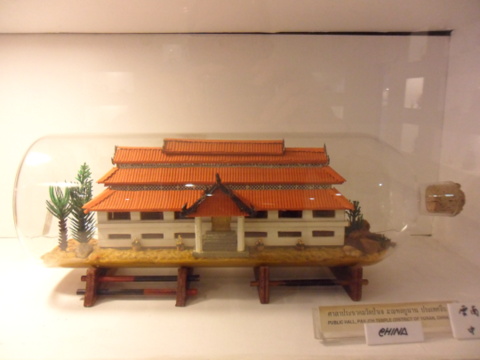
Pah Jeh Temple, Yunnan, China 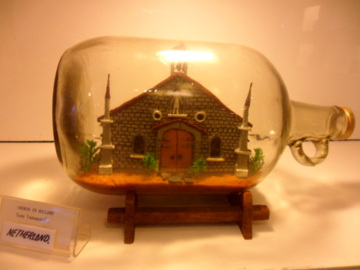
Church in the Netherlands 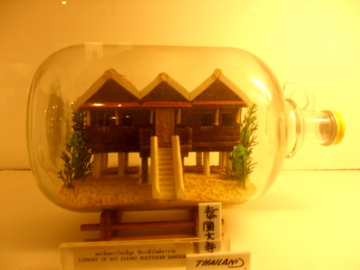
Library in Wat Rakhang, Thonburi, Bangkok Wat Rakhang is on the Thonburi bank of the Chao Phraya River. It’s about a km north Wat Arun the Temple of Dawn. The library was the home of King Rama I before he became king. After the fall of Ayutthaya, Thonburi became the capital in 1768 under King Taksin. After his death the capital moved over to Bangkok when King Rama I started the reign of the Chakri kings. 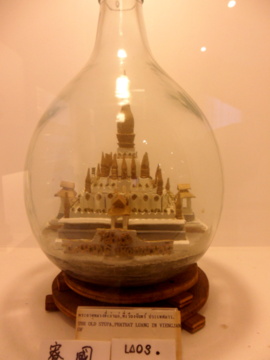
Stupa Pha That Luang Vientiane Pha That Luang, the most important religious structure in Laos, is located about five km north-east of Vientiane. It was first built in 1566 based on the ruins of a Khmer monastery dated around the 12th C. Wars with neighbouring countries in the 19th C, resulted in the destruction of the shrine. It was reconstructed in 1930. 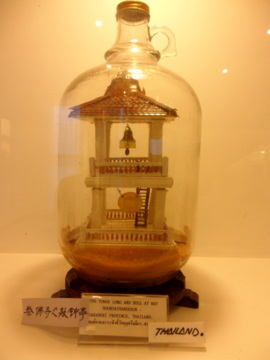
Bell tower, Wat Boonsrimanekron, Saraburi, Thailand 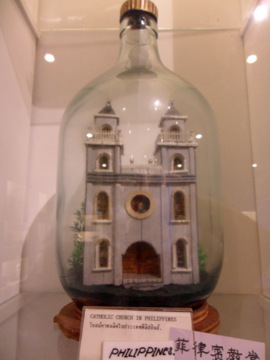
Catholic Church in the Philippines 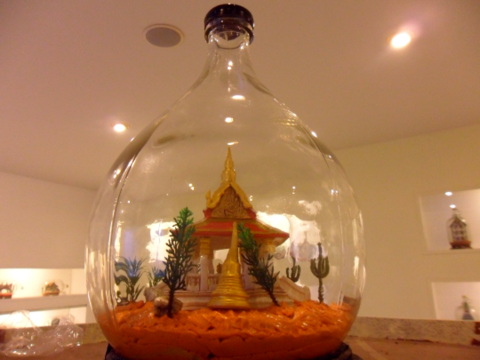
Centrepiece display in Room 2 Table of contents Bottle Art Museum - Room 3 The last room features the masterpieces, work that took up to a year. 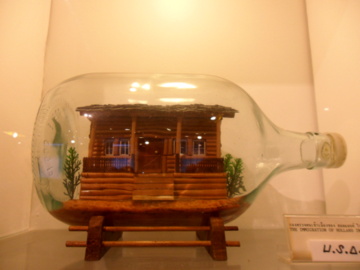
Log cabin, USA 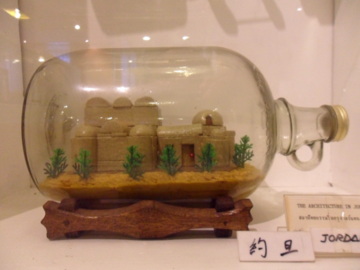
House in Jordan 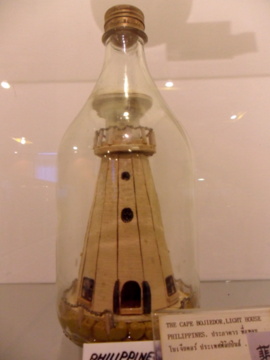
Cape Bojeador lighthouse, Philippines The Cape Bojeador lighthouse was built by the Spanish and first operated on 30 March 1892. The lighthouse is 16.3 m high and located at the north tip of Luzon Island in the Philippines on top of Vigia Nagparitan hill. It serves to guide ships navigating round the north of the Philippines to the Pacific to the east or South China Sea to the south. 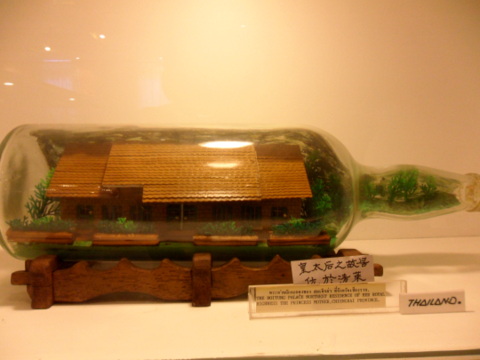
Doi Tung Royal Villa, Chiang Rai The Doi Tung Royal Villa in Chiang Rai, northern Thailand is the residence of the late HRH the Princess Mother, Princess Srinakarindra (1900 – 1995). It’s built with a harmonious blend of Lanna and Swiss architecture. Doi Tung is the name of the highest mountain in Chiang Rai at 1,389 m above sea level. The area is very mountainous and home to several hill tribes. Doi Tung is also the name of a development project initiated by the Princess Mother to help the impoverished hills tribes who were surviving on slash and burn cultivation and opium growing. The project covered the mountainous area of 15,000 hectares with about 11,000 inhabitants. The project provided basic health and education services to the hills tribes. The hills tribes were also encouraged to grow cash crops, make hand-woven products and other handicraft. These products were bought by the foundation and marketed in major Thai cities. Doi Tung Cafes sell coffee and coffee beans grown in this area. Doi Tung Lifestyle shops sell hand-woven apparel and other products. The hills tribes stopped growing opium and destroying the forests and the area was gradually reforested. The hill tribes fondly referred to the Princess Mother as Mae Fah Luang (Royal Mother from the Sky) as she frequently visited their villages which are only accessible by helicopter. The Princess Mother passed away on 18 July 1995. With her passing, the hill tribes people lost a great patron and benefactor. 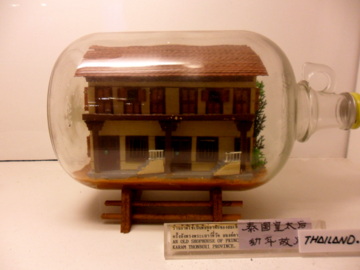
Shop house in Thonburi, Bangkok Thonburi is a district on the west bank of the Chao Phraya across from Bangkok. Administratively it’s still part of Bangkok city. For the stretch of the Chao Phraya River that passes through Bangkok, Thais refer to the west bank as the Thonburi bank and the east bank as Bangkok. 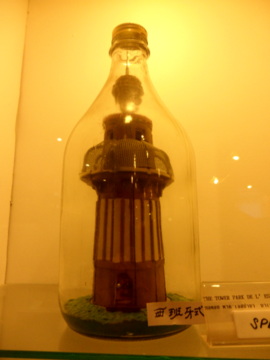
Tower in Parc de l’Espanya Industrial, Barcelona Parc de l’Espanya Industrial is a public park in Barcelona built in 1985 in an area of 4.6 hectares (11 acres). The park was the site of a former textile company called L’Espaya Industrial hence the name adopted by the park. The grounds of the park has several sculptures and a huge artificial lake the banks of which are lined with towers. The model in the bottle represents one of those towers. In the 1992 Summer Olympics in Barcelona, Parc de l’Espanya Industrial was the venue for the weight-lifting competitions. 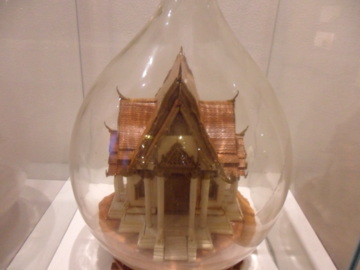
Buddhapadipa Temple, Wimbledon London Buddhapadipa Temple is a Thai Buddhist temple in Wimbledon London. Built in 1980 in traditional Thai architecture, it’s the first Buddhist temple in the United Kingdom. Here’s a masterpiece that’s too good to miss. 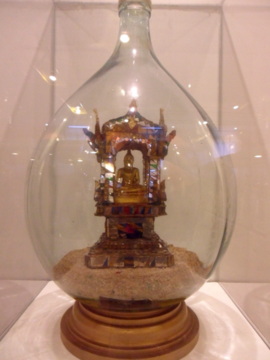
Buddha in a bottle Table of contents Souvenir shop When you have finished touring the three exhibition rooms, the exit door will lead to the souvenir shop with a canteen selling refreshments. The souvenirs on sale are very attractive bottle art. 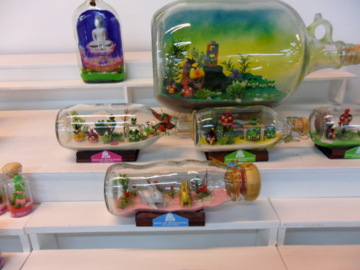
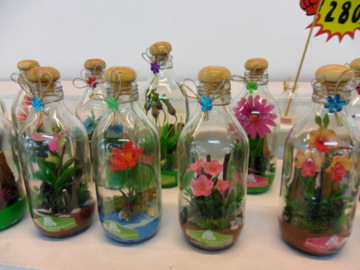
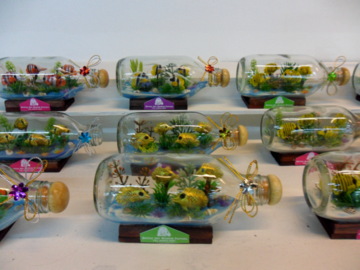
Table of contents Map to the Bottle Art Museum View Bottle Art Museum, Pattaya in a larger map Getting to the Bottle Art Museum The museum is presently located within the premises of the Kingston Park College which is directly opposite Mini Siam a theme park with scaled down models of places in Thailand. The location is approximately at the 143 km mark along Sukhumvit Road. The other main landmark in the area is the Bangkok Hospital, Pattaya. Just enter the main gate of the college and follow the signboard, the entrance to the museum is the rear of the main building. Admission fees Adults 200 baht Children 100 baht Thais 100 baht Opening times The Bottle Art Museum is open every day from 0830 – 1730 hours Contact Bottle Art Museum 297/1-5 Sukhumvit Road Tambon Nakluea Amphur Bang Lamung Chonburi 20150 Thailand Tel: +66 3842 2957 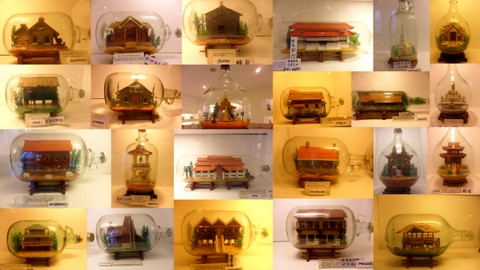
Table of contents Where to stay – hotels in Pattaya For hotels in Pattaya 
Table of contents Other attractions in Pattaya Pattaya floating market Sanctuary of Truth Viharn Sien Table of contents Next month The Silverlake Vineyard, Pattaya 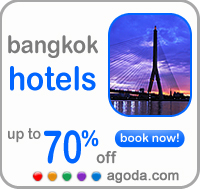

If you enjoyed reading this e-zine, please forward it to a friend. If you received this from a friend and found it interesting, please subscribe at Bangkok Travelbug. What you think of the Bangkok Travelbug? We love to hear from you What other subscribers have said Till next month then. Eric Lim Find us on Facebook Stay updated with what’s new at Tour Bangkok Legacies. Copy the link below and paste it into your Google Reader, NetNewsWire or your favourite feed reader. https://www.tour-bangkok-legacies.com/tour-Bangkok-legacies.xml If you use My Yahoo! or My MSN, head over to my home page and click on the button for your favourite Web-based feed reader. Visit our home page at Tour Bangkok Legacies. Copyright@2008-2012 Tour Bangkok Legacies All rights reserved |
| Back to Back Issues Page |